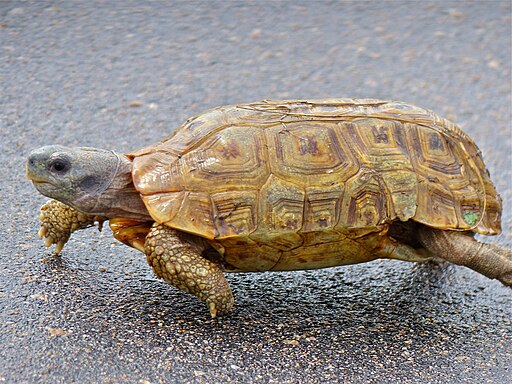Superregnum: Eukaryota
Cladus: Unikonta
Cladus: Opisthokonta
Cladus: Holozoa
Regnum: Animalia
Subregnum: Eumetazoa
Cladus: Bilateria
Cladus: Nephrozoa
Superphylum: Deuterostomia
Phylum: Chordata
Subphylum: Vertebrata
Infraphylum: Gnathostomata
Megaclassis: Osteichthyes
Cladus: Sarcopterygii
Cladus: Rhipidistia
Cladus: Tetrapodomorpha
Cladus: Eotetrapodiformes
Cladus: Elpistostegalia
Superclassis: Tetrapoda
Cladus: Reptiliomorpha
Cladus: Amniota
Classis: Reptilia
Cladus: Eureptilia
Cladus: Romeriida
Subclassis: Diapsida
Cladus: Sauria
Cladus: Archelosauria
Division: Pan-Testudines
Division: Testudinata
Ordo: Testudines
Subordo: Cryptodira
Superfamilia: Testudinoidea
Familia: Testudinidae
Genus: Kinixys
Species: Kinixys spekii
Name
Kinixys spekii Gray, 1863
Vernacular names
čeština: Želva Spekeova
English: Speke's hinge-back tortoise
日本語: スピークセオレガメ
Speke's hinge-back tortoise (Kinixys spekii), also known commonly as Speck's hingeback tortoise,[2] is a species of turtle in the family Testudinidae. The species is endemic to Africa.
Etymology
The specific name, spekii, is in honor of English explorer John Hanning Speke.[3]
Description
K. spekii has an elongated carapace, up to 20 cm (7.9 in) in straight length, which is distinctly flattened, allowing it to seek refuge in rock crevices and under logs (the co-occurring pancake tortoise is even more flattened). Its carapace has a weak, disrupted medial keel, and posterior marginals that are neither strongly serrated nor reverted. This species has a well-developed hinge at the rear end of the upper part of its shell, permitting the protection of its rear legs after they have been retracted.[4] The male has a notably longer tail than the female of this species, and the tails end in a spine. Females possess a flat plastron, yet males have a more concave one.[2]
Geographic range
Speke's hinge-back tortoise is found in East Africa from Uganda and Kenya south to Swaziland, next to Mozambique and Zululand. Its range extends westwards as far as the coast of Angola.[5]
Habitat
K. spekii inhabits savannahs and dry bush with rocky areas. It tends to inhabit more wooded areas during the dry season, and to move out into the savannahs when the summer rains come.[citation needed]
Diet
K. spekii feeds on small flowers, leaves, grass, herbs, succulents and fungi. It also eats snails and other small invertebrates, having a special preference for millipedes.[4]
Reproduction
Females of K. spekii lay a small clutch of two to four eggs in the summer.[citation needed]
References
Fritz, Uwe; Havaš, Peter (2007). "Checklist of Chelonians of the World" (PDF). Vertebrate Zoology. 57 (2): 286–287. ISSN 1864-5755. Archived from the original (PDF) on 2010-12-17. Retrieved 29 May 2012.
Tabaka, Chris, DVM (2003). "Differentiating Male and Female Kinixys spekii (Speck's [sic] hingeback tortoise)". World Chelonian Trust. Chelonia.org
Beolens, Bo; Watkins, Michael; Grayson, Michael (2011). The Eponym Dictionary of Reptiles. Baltimore: Johns Hopkins University Press. xiii + 296 pp. ISBN 978-1-4214-0135-5. (Kinixys spekii, p. 249).
nlbif.eti.uva.nl Archived 2011-06-08 at the Wayback Machine.[dead link]
Species Kinixys spekii at The Reptile Database www.reptile-database.org.
Further reading
Gray JE (1863). "Notice of a new Species of Kinixys and other Tortoises from Central Africa". Ann. Mag. Nat. Hist., Third Series 12: 381-382. (Kinixys spekii, new species).
Retrieved from "http://en.wikipedia.org/"
All text is available under the terms of the GNU Free Documentation License


